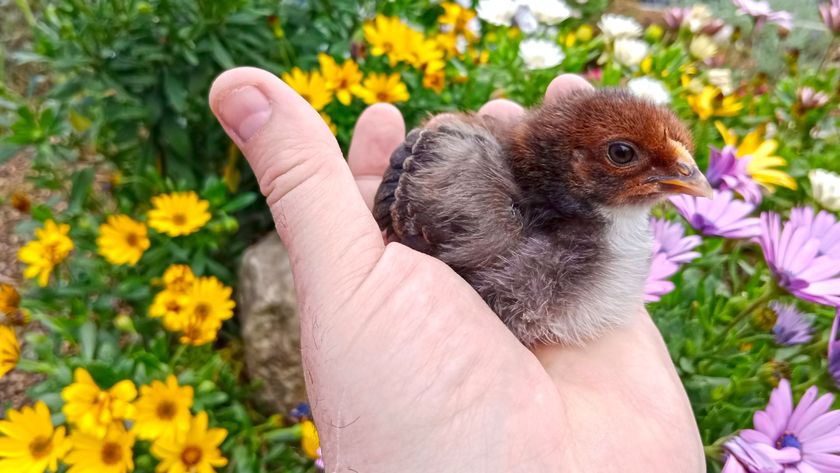What colors can cats see? A vet reveals the answer (and it may just surprise you!)
We asked a vet 'what colors can cats see?' Here's what they had to say...

What colors can cats see? If you have a feline friend in your family, it's a question you may have found yourself asking — and you're far from alone!
A cat's eyesight is something that has long baffled pet parents and scientists alike, with many of us curious about how our cat's see the world. When you look at a beautiful sunrise or sunset, for example, you see a range of different colors, but you may wonder what your cat sees when taking in the same view.
The good news is, cats can absolutely see color, which will come as a relief if you've spent money investing in a range of the best interactive cat toys in bright and bold hues! However, while your cat's world is not entirely black and white, they're not able to see the full range of colors that we can.
As a a cat owner, this is a great piece of information to be aware of. When you're looking for fresh ways to bond with your cat, keeping in mind that they'll likely prefer to play with you using yellow and blue toys more than red ones (a color they can't see), will ensure you create time together that's fun for both of you.
We wanted to delve deeper into this question of what colors cats can see, so we sought the expertise of Dr. Rebecca MacMillan. Below, she explains exactly what colors your kitty can see, why they can't see red, and how their vision stacks up against your own.

Dr. Rebecca MacMillan is a companion animal vet with over 13 years of experience treating and looking after pets. She graduated from the UK Royal Veterinary college in 2009, and has worked in several practices over the years. Rebecca is also an experienced writer, using her veterinary background to offer expert opinion and advice.
Can cats see color?
Yes, cats can see color but they don't see as many shades as we humans do.
"Cats can see some color but they don’t see the full spectrum, so they are less able to differentiate various shades and tones," MacMillan explains. "They see color via special photoreceptive cone cells in the backs of their eye (retina), just like we do. These cells detect different wavelengths of light, sending a message to the brain accordingly to be interpreted as color.
"There are three types of cone cells, red, blue, and yellow. Research is ongoing in this area however, with some scientists suggesting that cats may only have two of these types of cone cells (blue and yellow) with other studies showing the possible presence of the third type of cone cell too (red). Humans have 10 times more cones in their eyes than cats do, which explains why they see less of a color range than us."
Because our feline friends can't see the full spectrum of colors like we do, they tend to rely more on brightness and movement to help them navigate the world around them.
What colors can cats see?

Because cats are believed to only have two of the three cone cells needed to see the full range of color, they're likely to be more limited in exactly what colors they're able to detect.
"It is thought that cats see blue and yellow the best, with other colors appearing to be on a grey scale in comparison to how we would view them," says MacMillan.
This is important to know — especially if you have some of the best automated cat toys with lasers lying around the house. Why?
Well, often we choose to purchase brightly colored toys because we think they'll be more exciting for our cats. However, cat laser toys feature a red beam and most scientists believe that cats can't see anything on the red-orange color spectrum. So while your cat may play with the toy, they're actually responding to the movement of the beam and not the color of it.
Why can't cats see red?
Unlike we humans, cats don't have cones that are sensitive to red wavelengths — that means that they lack the light-sensitive pigments at the back of their eye that enable them to see red.
"Although some studies point towards cats having all three types of color-detecting cone cells, they are unable to see the red-orange wavelength all that well. This may be because there are fewer of the specific cones that are sensitive to red, compared to larger numbers of yellow and blue-detecting cones," explains MacMillan.
"This means that shades of pink and red will look more like green to them, and purple will appear as blue color. However, studies into the number of cone types that cats have are not certain and research is ongoing."
It's important to take note of your cat's inability to see red and to choose colors that are easily visible to them. Serving up the best dry cat food in a blue bowl, for example, will likely draw them in more than if you use an orange one.
How does a cat's vision compare to human vision?

"A cat’s vision differs from ours in that they have a small range of sharp vision, meaning they need to be quite close to an object to see it clearly. Their longer-distance vision would therefore be quite blurry compared to ours. However, cats have a field of vision that is much wider than us, giving them a fish-eye lens view of the world," explains MacMillan.
That being said, what cats lack in color perception they more than make up for when it comes to their ability to see dim light.
"Cats can see better at low light levels, thanks to how wide their pupils can expand and other specialized mechanisms," confirms MacMillan. This includes rod cells, which cats have in abundance. Rod cells are great in dim light and are brilliant at picking up darty movements, which is what gives cats their outstanding hunting abilities.
Can cats see in the dark?
Absolutely! While cats don't have night vision in the way we might imagine them to have, they can see very well in low light, a trait that's necessary to give them an advantage over their prey.
So, exactly how well can our feline friends see in the dark?
"It is thought that cats only require about one-sixth of the amount of light that we need to be able to see, giving them a clear advantage at night. Their pupils can dilate much wider than ours can, allowing more available light into their eyes," MacMillan says.
Cats also have vertically slit pupils as opposed to our round ones. This means that their pupils will constrict in bright sunlight and dilate in the dark to help them see better — something that ours don't do anywhere near as effectively. To put it into perspective, a cat has the capacity to alter the intensity of light falling on its retina 135-fold, compared to tenfold in a human.
"They also have more rod cells in the backs of their eyes which help to accentuate dim light and allow cats to detect motion well. This is particularly useful for night-time prowling, hunting, and keeping an eye out for potential rivals," adds MacMillan.
So there you have it — our feline friends indeed live in a colorful world, just not quite so colorful as the one we inhabit. While they may not be able to see anything on the red-orange spectrum, they can see colors like blue and yellow.
And while they may lack the variety in color perception that we have, they more than make up for that with how well their vision operates in dim light, an area where they their eyes well and truly outperform our own!
Enjoyed this piece and looking for more great kitty content? Here's 32 things you only know if you're a cat owner and a selection of our favorite ways to be the best cat owner you can be.
PetsRadar Newsletter
Get the best advice, tips and top tech for your beloved Pets

Kathryn is a freelance writer who has been a member of the PetsRadar family since it launched in 2020. Highly experienced in her field, she's driven by a desire to provide pet parents with accurate, timely, and informative content that enables them to provide their fur friends with everything they need to thrive. Kathryn works closely with vets and trainers to ensure all articles offer the most up-to-date information across a range of pet-related fields, from insights into health and behavior issues to tips on products and training. When she’s not busy crafting the perfect sentence for her features, buying guides and news pieces, she can be found hanging out with her family (which includes one super sassy cat), drinking copious amounts of Jasmine tea and reading all the books.











